How to Master Water Balance in Gouache Painting
The funny thing about water is that it can be your best friend in gouache painting. It helps your paint flow, mixes colors, and even provides cool effects. But here’s the big catch—it can also become a rogue enemy, causing your gouache to become too watery or even encouraging mold in your palette (yikes!).
So, how do you master this delicate dance with water? I’ll share some tips I’ve learned along the way. Let’s make a splash, shall we?
Table of Contents
- Your Too Sticky or Too Thin Mix – An Enemy Alert!
- Balance is Key – No More, No Less
- Water – Your Ally in Disguise
- Wrapping Up
Your Too Sticky or Too Thin Mix – An Enemy Alert!
Water in brush
If your mix doesn’t have enough water, your paint can turn sticky. Add too much, and you’ll get only a translucent effect. These are common mistakes, but thankfully, they are easy to avoid once you understand how to manipulate your paint correctly.
A little bit of water goes a long way. When you first start with gouache, adding more water than you really need is tempting, especially if you come from watercolor. But if your paint is too thin, you won’t be able to build up layers of color without your colors bleeding into each other.
You risk sticking your paint to the paper if it’s too thick. When the paint is too thick, it isn’t easy to move it properly. You can add a little water at a time and mix again until the proper consistency is achieved.
Knowing your gouache brands
Just like people have unique characteristics, each brand and pigment boasts distinctive consistencies, even straight from the tube. Whether it’s a sticky texture, crumbly consistency, or a perfect creamy blend – the experience can differ.
Consider this a call to know your paint brands better. Test your colors from different brands by starting with a damp (not drenched) brush.

Be wary. If you go for very wet brushes with creamy paints, that will turn out poorly!
Water on the palette
On your palette, remember to hydrate your paints well. If the paint dries out, you’ll encounter difficult crumbles to rehydrate, and you’ll never get back that creamy consistency that makes gouache so beautiful to work with. It’s like skincare – you need to moisturize, or you’ll get dry and wrinkled results!
Don’t get me wrong. You can use dry gouache paint, but that’s another story.
If you’re using an airtight palette, cater enough water. Otherwise, your paint will dry like a watercolor pan. But if you add too much water, you risk getting mold inside.
Balance is Key – No More, No Less
With gouache, it’s all about achieving that perfect medium.
Too much water yields a transparent, ‘watercolor’ effect, whereas with too little, your gouache won’t spread smoothly, leaving you unable to paint detailed elements. Gouache is all about creamy opacity, with enough thickness to create beautiful blends and gradients.
Adjust your water-to-paint ratio according to the brand you’re using, the specific color within that brand, and the effect you’re trying to achieve. Fine-tuning makes all the difference.
Water accidents
If you accidentally spill water onto a finished painting, you can blot it up with a tissue if you notice it right away. If it dries before you catch it, blend it gently with a clean, damp brush to spread the pigment around the water spot. This makes the color lighter overall, reducing the contrast between the spot and the surrounding paint.

Water – Your Ally in Disguise
But water isn’t just a challenge – it can also be a fantastic tool in your gouache art arsenal.
For example, it’s excellent for softening hard edges, which can transform your painting’s overall look. Dip your brush in clean water, wipe off the excess, and gently rub the edge of your two colors.
Moreover, you can also use water to blend large areas. You can moisten your painting using a spray bottle with tap water, encouraging your colors to blend softly for that dreamy, Impressionistic effect.
Wrapping Up
While consistency is an issue most beginner gouache painters grapple with, remember that it takes time to understand the balance between paint and water. There’s no exact science when it comes to painting. It’s all about experiencing and learning.
Keep exploring, testing your brands and colors, and playing with your water levels. Your journey in gouache painting is about developing your unique style. And soon, you’ll be turning water from your potential enemy to your steadfast ally!
Happy painting!







